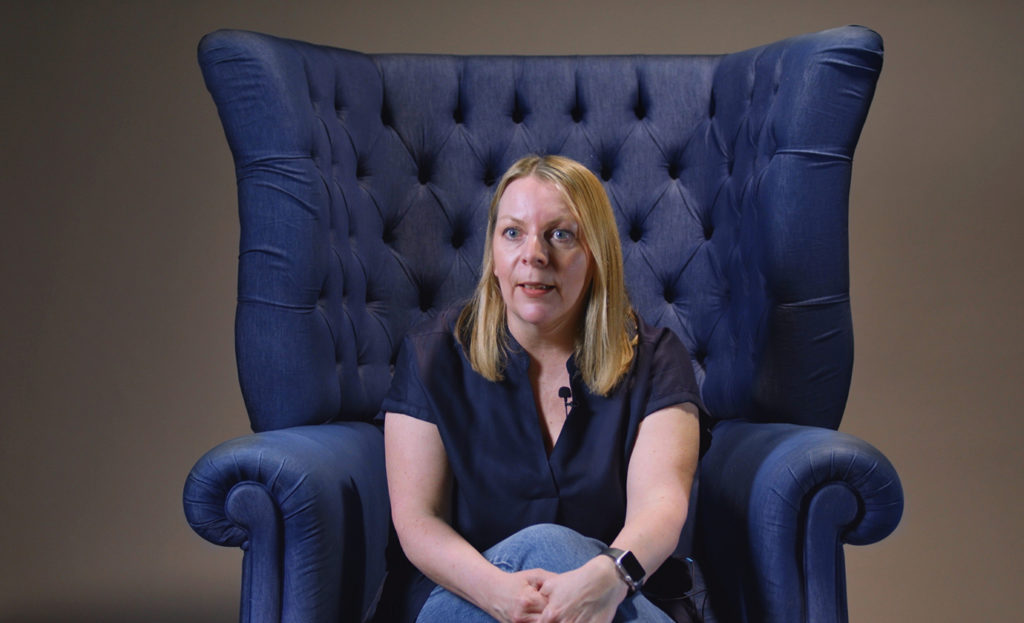
Salli Deighton’s Denim Mission
As a denim designer in the 1990s, Salli Deighton owns the role she played in the oft-harmful industry. Now a denim consultant for ASOS and Gas Jeans who collaborates with retailers and mills, she’s determined to help others create in more sustainable, ethical and responsible ways.
As part of the Modern Definition of Denim video series, Carved in Blue talks with Salli about what the industry got wrong for so long—and all of the incredible progress the denim family has made on its journey.
Carved in Blue: What is the modern definition of denim?
Salli: The modern definition of denim is to create a fantastic, vintage, authentic piece of denim but very responsibly.
Everything needs to be considered, from the fabric, how’s it dyed, how’s it finished, how it will wash down quickly in the laundry and respond to laundry technology. We need to ask what fibers are in the fabric & are they sustainable. Can we use something like a REFIBRATM? Or recycled fibre in the fabric? Are we using stones or can we eliminate them? How are we going to create a garment with very little water? Is the fabric dyed in w a way to support easy wash down and laser? Many questions and considerations.
So, to me, the modern definition of denim is just a beautiful piece that we think about in a very, very different and caring way.
Carved in Blue: How has that definition evolved through the years and why?
Salli: When I started in the industry, we still washed in the U.K., and we had belly machines sloshing around with water and stones and a real high smell of bleach. We spent the last few years really trying to tidy up the industry. Over the last decade we’ve seen a real change in the way we process denim and everything is now available to be able to make much better garment . We’ve got no excuse for not making responsible denim.
The definition of a modern Jean has evolved as the technology and resources have improved.
When the Rana Plaza incident happened in Bangladesh, I got actively involved with a NGO and with brands who were keen to make the changes. That’s when I got introduced to many technical people such as Tonello, Jeanologia, Archroma etc who’ve really worked hard to make this a cleaner industry for all of us. They’ve given us the support & tools to be able to make better denim.
Back in the ’90s, I went into many laundries in China and Bangladesh that were very unhealthy. We saw kids (well we were told they were 18) spraying resin, slapping an iron down to create 3D creasing. It was glue sniffing on a mass scale. It’s been a really filthy and dangerous industry. I also saw rivers in Portugal that were purple and red depending on the dye shade of the day. I mean, it was horrific what was going on. It was definitely time that we cleaned up.
Now we don’t have any excuse at all, because we’ve got better equipment, we’ve got better chemicals, better fabrics and we’re able to make our industry as clean as it can be. I feel personally responsible, because I was one of the people who was creating these jeans in the ’90s. My job is to help share what I’ve learned and make this new way of making denim happen with as many of the factories and retailers as I can.
Carved in Blue: What progress are you most proud of?
Salli: I’m very proud of the work we’ve done overseas with a lot of the Asian factories and this is on going. There’s a real pride in our industry, and that goes right through to everybody that works in the factory.
I think the introduction of new equipment into the laundries, such as laser machines, more water efficient front loaders, ozone and the core and e-Flow machines has given us the ability to do the job. Seeing that equipment being used on a daily basis and reducing water consumption by a dramatic amount of litres makes me really proud. Once we get a factory up and running and they’re working with this equipment in a very efficient way. Everyone feels a sense of achievement.
Carved in Blue: What elements will always stay in the heritage of denim?
Salli: The root of denim is workwear. It will always at the heart of denim and what we do. We’re just making sustainable workwear now. Ultimately denim started life as a heavy cotton twill fabric, and it was very functional and practical and that remains the same today. These days there might be a different twist on it—we might be using Coolmax® Eco [or] it might be a scientific bio fibre invention to enhance your well-being or improve the way you feel when you wear your denim—but still workwear is always at the heart of what we do.
Denim has now become a real science.
I look at the jean now and I think of a modern jean. On my morning commute across London, 80 percent of people heading to work are wearing jeans. Ten years ago in the U.K. companies only permitted people to wear jeans in a Friday. Now there is a sea of denim every morning, and it’s become the norm. It’s become everyday workwear, and the fact that we’re making these garments sustainable makes it even more incredible.
Carved in Blue: Has it been hard for you to be at that generation in between—realizing what you had before and then trying to fix it? How did you feel at the start of this journey, and how are you feeling now?
Salli: As I said, I’m very responsible for what happened in the ’90s and I think a lot of my peers would say the same. I think we all love what we do so much, and we want to put it right. We’re absolutely determined that we’re going to make better denim, and the aim is to get to circular fashion.
It was quite hard at the beginning. In the late 2000s when we started to look at the industry and what needed to happen there just weren’t the solutions there. I think over the last five to six years, the industry has been working closer together to deliver all the things we need. We had laser machines probably 10 years ago, but the fabrics weren’t designed to respond well to laser. Now the mills have changed the way they produce the fabrics to enable this. There are so many innovations and the technology improves daily.
We’re using less energy and it’s enabling us to deliver this much more affordably as well. I think the industry has been very collaborative, and now it’s up to the designers, buyers and developers to embrace this new way of working and learn every part of what can be done in detail to deliver the most sustainable products.






